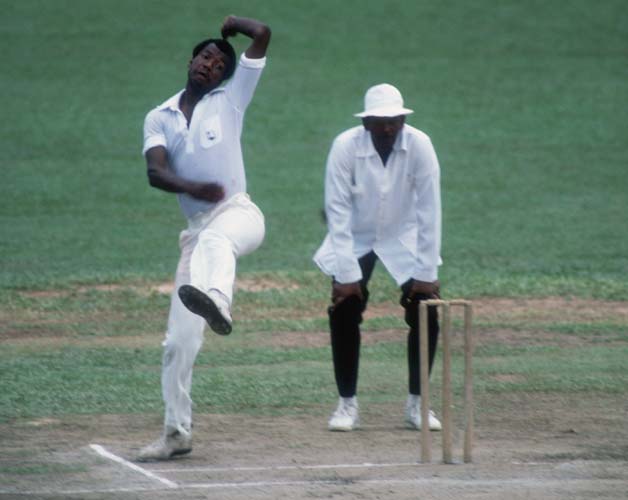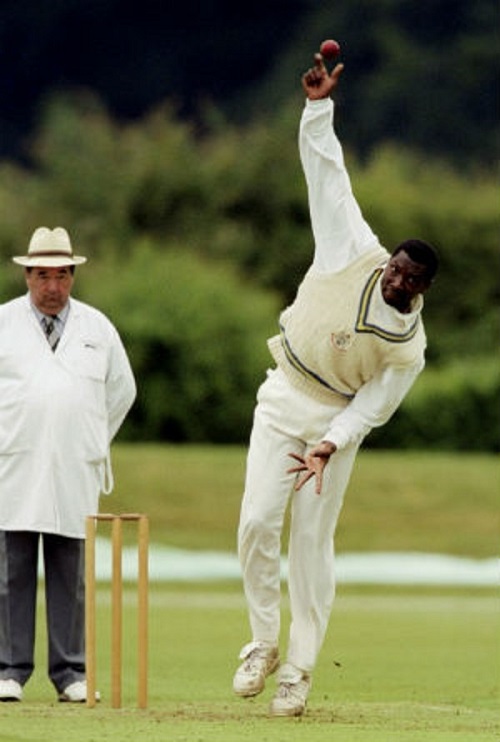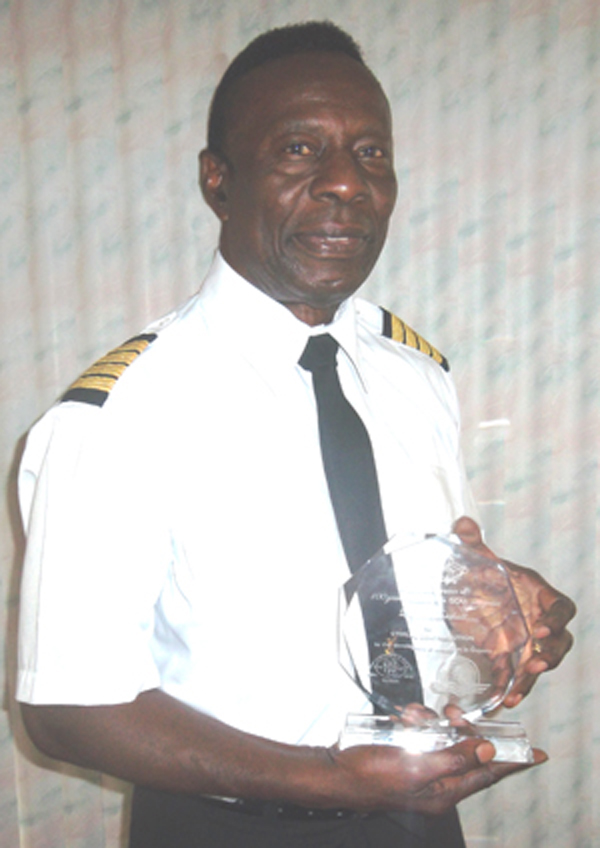There was Andy Roberts, shrewd, aggressive and vicious. There was Michael Holding, lithe, lethal and express. There was Joel Garner, accurate, miserly and destructive. And above everyone, there was Malcolm Marshall, the complete package, and arguably the greatest fast bowler of all time. But the meanest of the pack? That had to be Colin Croft.
In all probability, Croft did not have a single defensive bone in his body. He often ran in so close to the stumps that he almost came in the way of the umpire’s vision of the batsman. He steamed in with a furious intent; when the batsman finally got to see him, he swerved away towards his left at an awkward angle.
It was an action different from any other bowler in history. And few bowlers made judicious use of the crease width than Croft. He angled the ball in at an express pace; it could well have been a toe-crushing Yorker, or a menacing, unsympathetic bouncer that the batsman often had issues fending off due to the uniqueness of the angle. With his 6’5” frame, strong and muscular shoulders, chest-on action, and ruthless attitude, Croft was a menace to the batsman. Had his career not been curtailed due to a rebel tour, he would probably have attained the same stature of some of his teammates.
Croft’s numbers were still fantastic by any standards. From 27 Tests he took 125 wickets at 23.30 and a strike-rate of 49.3; in the shorter version, Croft took 30 wickets from 19 One-Day International (ODIs) at an average of 20.66, a strike-rate of 35.6, and an economy of 3.47. These are phenomenal numbers by any standards, and for any era.
To put things into perspective, if we put a 100-wicket cut-off, Croft’s Test average is next to only Marshall, Garner and Curtly Ambrose — all champions of the sport — among West Indians. If we apply the same criterion, his Test strike-rate is next to only Marshall’s 46.7
Early days
Croft burst early into the limelight early in his international career. Making his debut alongside Garner against Pakistan at Bridgetown, Croft overshadowed Roberts and Garner with match figures of seven for 132 on debut. Croft hit opener Sadiq Mohammad on his forearm and forced him to retire hurt, and then blew apart the Pakistanis in the next Test at Port-of-Spain with figures of eight for 29 with ferocious pace. The figures are still the best for any West Indian fast bowler.
Croft continued to wreck Pakistan, picking up three for 50 on his ODI debut at Albion in the same series. He finished the Test series with 33 wickets from five Tests at an average of 20.48, and a strike rate of 39.6. All three numbers were the best in the series from either side. Two new fast bowlers had now appeared to join Roberts and Holding — the first great pace quartet in the history of the sport.
Next year, once again at Port-of-Spain, Croft opened bowling with Roberts, and ripped through the Australian top-order, finishing with figures of four for 15 — bowling Australia for 90. He repeated the feat with four for 47 in the next Test at Bridgetown, and once again Australia lost by plenty. In the World Cup next year, Croft took eight wickets from four matches at 17.50 and an economy of 3.08, and was a crucial cog in Clive Lloyd’s path to victory.
Later that year, Croft helped his side trounce the Australians at their own den. He did not take five in an innings, but he still managed to pick up 16 wickets — the most from either side — from the three Tests at 23.62 and a phenomenal strike rate of 45.5.
The New Zealand series and Fred Goodall
The New Zealand series turned out to be the only one West Indies lost during an unbeaten run that spread over close to two decades. It had to do a lot with non-cricketing reasons, though.
In the first Test at Dunedin, Holding had (in all probability) induced an edge off John Parker, but umpire John Hastie had turned the appeal down. A furious Holding walked to the batsman, and kicked a couple of stumps straight out of the ground. He had to be coaxed by Lloyd and Deryck Murray to stay back. New Zealand went on to win the Test by one wicket despite some hostile bowling from Holding, Garner, and Croft.
In the next Test at Christchurch, the umpiring was so atrocious that the West Indians decided to empty the dressing-room at the end of the Third Day, determined not to continue with the tour. It took a three-hour meeting to convince them as they returned in a sour mood.
Croft bounced to Richard Hadlee, and found his edge. Umpire Fred Goodall turned the appeal down. By now, Croft was fuming, and he swore at Goodall. Lloyd intervened, and though play got under way, the bitterness hardly reduced. In the next over Croft unleashed a bouncer barrage to Hadlee, and Goodall called a no-ball — Croft’s 11th of the innings — when the bowler went a bit too much towards the corner of the crease.
By now Croft’s temper had got the better of him, and the jeer from the crowd did not help: as he went back to his bowling mark, he intentionally knocked off the bails at the non-striker’s end. It may have resulted in another rift, but Jeremy Coney, the non-striker, calmly picked up the bails and replaced them.
Croft ran in again with his characteristic run-up that made him emerge from behind the umpire at the very last moment. Just before he swerved away to his left as he typically did, he shoulder-barged Goodal. This immediately caused a huge furore, and the umpires approached Lloyd again. Lloyd did not, however, move from his position in the slips, waiting for the umpires to reach up to him.
Goodall later mentioned, “It hurt for a while. I told Lloyd I have taken some treatment from players in my time, but it has always been verbal.” Lloyd did not take Croft off. He once again showered Hadlee with bouncers, including one that went way over Murray’s head for four byes. He conceded 15 in the over, and had to be taken off.
Croft claimed it was unintentional, though: “In the heat of the moment they thought I did it on purpose. I did not do it purposely. If Fred Goodall was in Hollywood, he’d have picked up an Oscar. I’m six foot and 230 pounds. If I’d meant to hit him, he wouldn’t have got up. It’s crap that I barged him deliberately.”
Lloyd complained at the end of the series: “Our bowlers appealed several times, but it got to the ridiculous stage when they weren’t even appealing. They knew they wouldn’t get the decision.” West Indies lost the series 0-1 — their only chink in an otherwise commendable two decades.
Back to normalcy
Once the series was over, Croft was back to his destructive best after an indifferent series on English soil. When the English toured West Indies, they ran into Croft at his violent best in the first ODI at Kingstown. Being bowled out for 127, West Indies did not have a serious chance of winning the Test. Croft ripped open the heart of the English batting line-up, and returned figures of 9-4-15-6 to bowl them out for 125. It was even more astounding, since 10 of those runs had come off a single over.
Back at his favourite hunting ground Port-of-Spain in the first Test, Croft wrecked the English again — this time with five for 40 — and England lost by an innings. He took seven more wickets at Bridgetown, and in the fourth Test at St John’s, he bowled his heart out on a flat pitch, taking six for 74 and two for 39 — eight wickets out of the 13 West Indies managed to snare. Once again he headed the bowling chart for either side by a mile — 24 wickets from four Tests at 18.95 and a strike rate of 39.4.
End of international career and the rebel tour
And then, after another tour of Australia, he vanished from the scenario altogether. He went on a rebel tour to South Africa, which sealed his international career for good. He did not exactly set the world on fire with his bowling, but he made it to the news for a totally different reason.
Croft was kicked out of a train compartment at Cape Town — for the simple reason that it was a Whites-only carriage. It was a source of great humiliation to the apartheid Government, and though there were apologies all around, Croft’s belief that sports could help solve political issues took a major blow.
Fifteen years after the incident, the white man in question (Raymond Roos) and the conductor of the train (Willie van Zyl) approached Croft during West Indies’ tour to South Africa, and apologised profusely.
Unlike many others, Croft never apologised for being a part of the rebel tour, citing the reasons “I guess money is everybody’s God” in his defence.
Later years
Few people have turned out to be as versatile as Croft in their post-career days. He qualified as a pilot; he taught mathematics at a school in Berkshire; he was one of the earliest long-term online cricket columnists; he also became a part of BBC’s Test Match Special, and still serves as an expert, making occasional appearances on Sky Sports as well. His brazen, no-nonsense commentary is often reminiscent of his days with the ball.
(Abhishek Mukherjee is a cricket historian and Senior Cricket Writer at CricketCountry. He generally looks upon life as a journey involving two components – cricket and literature – though not as disjoint elements. A passionate follower of the history of the sport with an insatiable appetite for trivia and anecdotes, he has also a steady love affair with the incredible assortment of numbers that cricket has to offer. He also thinks he can bowl decent leg-breaks in street cricket, and blogs at http://ovshake.blogspot.in. He can be followed on Facebook at http://www.facebook.com/ovshake and on Twitter at http://www.twitter.com/ovshake42)






